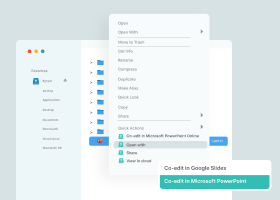Online File Sharing
Online file sharing is the practice of sharing or offering access to digital information or resources. This includes documents, folders, audio or video files, graphics, or entire applications. The type and size of files that can be shared vary based on the program being used. Some applications for online file sharing limit the size of each file, while others allow users to transfer files of any size.
A key feature of online file sharing is the ability to offer different levels of privileges for access and use. Based on the access levels, users are allowed to collaborate and share information seamlessly. In some cases, users can work on the same file at the same time.
Let’s jump in and learn:
Online file sharing can be used for the private or public distribution of data or resources in a network. There are several ways that online file sharing can be done. The most common techniques for online file sharing, storage, distribution, collaboration, and transmission include the following.
- Centralized file hosting server installations on networks
- Distributed peer-to-peer networks
- Network protocol (e.g., FTP)
- Operating systems (e.g., network file sharing or NFS)
- Web-oriented hyperlinked documents

Why Is Online File Sharing Important?
Online collaboration is important because it provides a unified platform to help users work together efficiently regardless of where they are physically located. Most organizations have users working from multiple locations at any given time. Online file sharing unifies them and enables them to work as if they were in one place.
How to Use Online File Sharing
Four of the main ways how to use online file sharing are:
1. System local file sharing
Sharing files using a local area network (LAN)
2. Client-server file sharing
Storing files in a server and sending them to users upon request (e.g., FTP)
3. Peer-to-peer (P2P) file sharing
Cutting out the server and sharing files directly from one computer to another
4. Cloud-based file sharing
A cloud-based file-sharing program lets you store content in the cloud — a system of Uploading files to the cloud for remote access
Online File Sharing for Businesses
The increase in remote workers has driven organizations to either expand their use of online file sharing or move to implement a system. It has become a must-have for any organization trying to manage a remote workforce. Online file sharing streamlines workflows, allows people to collaborate remotely, and provides document protection.
There are many ways that business users engage with online file sharing. Below are a few of the core functions of online file sharing that are most commonly used.
- Comment on parts of files
In addition to making edits, authorized users can add comments to a file. There is also the capability for people to reply to comments, which allows for a faster and more streamlined review process.
- Collaboration on files
In some cases, multiple people are able to edit a file at the same time with the changes syncing in real time. - Download files
As with viewing, with proper permissions, users can download files. Conversely, if someone does not have a certain level of permission, they may only be able to view a file and not download it. - Edit files
Users with editing permissions can open and freely make changes to a file. Depending on the scenario, changes can be tracked and not incorporated until they have been approved. - Share files online
Usually, when a file has been edited by multiple people, those who have editing privileges are also able to share the document with others outside of the group. - View files
With online file sharing, a link is sent, and a person who has authorization can click the link and see the file.
Secure Online File Sharing
Every organization must ensure the security of online file sharing at every step. The repercussions of a data breach involving sensitive information are dire. They range from public outcry to legal implications related to regulatory compliance violations (e.g., the European Union’s General Data Protection Regulation or GDPR, Health Insurance Portability and Accountability Act or HIPAA, the Payment Card Industry Data Security Standard or PCI DSS). Five considerations when deploying an online file sharing system are:
1. Determine your use case and needs and implement the security systems and processes necessary to support the use cases.
2. Research the online file sharing options available and select the one that most closely aligns not just with the needs of users, but with the levels of security needed to meet the minimum standards required by the organization.
3. Put processes and procedures in place to effectively govern the use of online file sharing systems, including a robust training program that enables users not just how to use the tools, but how to do so in a secure fashion.
4. Ensure that only share files that need to be shared by implementing policies that enforce the principles of least privilege and using protocols to control who can access files and what they can do with them (e.g., view, edit, share).
5. Require the use of complex passwords whenever possible to restrict access to sensitive information to authorized users.
How Organizations Benefit from Online File Sharing
The right online file sharing and collaboration tools yield many benefits that permeate an organization. The reason is that online file sharing and collaboration make it easy for people to do their jobs. The results lead to enhanced productivity, improved employee retention, and, in many cases, increased profitability. Online file sharing and collaboration tools have played a crucial role in the efficacy of remote workforces. With online file sharing and collaborations, people are able to replicate many of the engagements that happened in person and, often, do so in a far more streamlined fashion.
Three key reasons why organizations benefit from online file sharing are:
Automated syncing and backup
An online file sharing platform provides a central repository for disparate files, which makes it easier to keep copies. Because all files are kept in together, backups are able to capture everything. All files, including revision history, are included in scheduled backups. This means that not only is the latest version available to all users, but also earlier versions can be easily accessed if needed.
Project management and collaboration
Online file sharing addresses one of the major concerns with mobile workforces—how to provide broad access to information and enable collaboration. Efficient sharing of information and the ability to support real-time collaboration have made online file sharing one of the most widely used technologies for organizations of all sizes. It bridges the physical gap between teams while providing the user experiences that people want and need and the data governance that organizations require.
Security
Without reliable security, online file sharing would not be feasible. The rich security feature set available with most online file sharing systems is what has allowed them to become ubiquitous and the mainstay of so many organizations’ operations. The built-in processes and technology, such as encryption for data in transit and data at rest, make online file sharing widely considered a more secure way to share information than most internally-run systems. In addition, to protecting information from unauthorized users, online file sharing helps maintain the integrity of information. With online file sharing, the master file, as well as past versions, are all stored in a central location.
Online File Sharing Benefits On-Site Teams and Remote Workforces
When it comes to online file sharing, this is a solution with benefits that touch everyone in an organization. Secure online file sharing can increase productivity and employee satisfaction while protecting sensitive data and communications.
Egnyte has experts ready to answer your questions. For more than a decade, Egnyte has helped more than 16,000 customers with millions of customers worldwide.
Last Updated: 16th August, 2023



